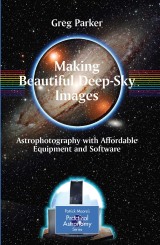Details

Making Beautiful Deep-Sky Images
Astrophotography with Affordable Equipment and SoftwareThe Patrick Moore Practical Astronomy Series
|
42,79 € |
|
| Verlag: | Springer |
| Format: | |
| Veröffentl.: | 20.09.2007 |
| ISBN/EAN: | 9780387713533 |
| Sprache: | englisch |
| Anzahl Seiten: | 177 |
Dieses eBook enthält ein Wasserzeichen.
Beschreibungen
I have recently discovered the most satisfying hobby so far, and to be frank, I have pursued quite a few hobbies in my time! This one encompasses computers, optics, precision mechanics, digital image processing and artistic appreciation, and it therefore satisfies just about every major interest I have in one go. The hobby is taking photographic images of the deep-sky. I have not met anyone, so far, that has not been moved, sometimes to a great extent, by the images you will find within the pages of this book. Some people will actually admit to being frightened by the vastness of space that these images depict. I am not frightened by these images, but I am certainly awe-struck by them, and they do make me feel rather insignificant regarding the grand scale of things. I am also still firmly in the grip of being totally amazed that the capability to take such awe-inspiring images is now available to anyone with sufficient time and effort to dedicate to this most rewarding of hobbies. This book has two aims. The first is to show you the richness, wonder, and beauty of deep-sky objects. The second is to show you how you can take these images for yourself, using readily available commercial equipment.
How did I start?.- The Beginning – and a Serious Health~Warning!.- Assembling your Imaging System.- Computational Considerations – Data Acquisition and Image Processing.- A Permanent Setup.- First Light – Choosing your Objects.- First Light – your First Objects.- Hyperstar Imaging.- Wide-Field Imaging with a Short Focal Length Refractor.- Basic Image Processing.- The Deep-Sky Images.- Differentiating your Work.- Your Largest Resource.- Book Recommendations.
<P>Professor Greg Parker is Head of the Nanoscale Systems Integration Group at Southampton University in Southern England. His deep sky astronomical images have been published in Astronomy Now and Sky at Night magazines. He is the author of Introductory Semiconductor Device Physics (IOP, ISBN 0750310219), and has written many scientific papers and articles, mostly in the area of photonics and optoelectronics, as well as a chapter (Guided-wave Optical Communications: Materials) in Elsevier’s Encyclopaedia of Materials: Science & Technology.</P>
<P>Amateur astronomers, using commercially available equipment, have taken some beautiful and awe-inspiring color photographs of deep-sky objects. But how?</P>
<P>Professor Greg Parker's astronomical photographs are widely known for their excellence, and a selection of them has recently been shown as a public exhibition in the UK. In <EM>Making Beautiful Deep-Sky Images</EM>, he provides a detailed account of how spectacular deep-sky images can be taken by amateur astronomers using CCD cameras, and how they can subsequently be processed and enhanced in the "electronic darkroom" for maximum beauty and impact. </P>
<P>You don't even have to own a big telescope. A range of telescopes and equipment is considered in detail, from Greg's 11-inch SCT down to lower-cost instruments. </P>
<P>Quite simply, this is a "how to do it" book for people who want to make stunning astronomical pictures.</P>
<P>Professor Greg Parker's astronomical photographs are widely known for their excellence, and a selection of them has recently been shown as a public exhibition in the UK. In <EM>Making Beautiful Deep-Sky Images</EM>, he provides a detailed account of how spectacular deep-sky images can be taken by amateur astronomers using CCD cameras, and how they can subsequently be processed and enhanced in the "electronic darkroom" for maximum beauty and impact. </P>
<P>You don't even have to own a big telescope. A range of telescopes and equipment is considered in detail, from Greg's 11-inch SCT down to lower-cost instruments. </P>
<P>Quite simply, this is a "how to do it" book for people who want to make stunning astronomical pictures.</P>
Describes how to take “Hubble class” deep-sky images from your back garden Explains how to process digital astronomical images Explains how to create your own awe-inspiring astronomical posters Describes how to put together an astronomical imaging system using commercial equipment for deep-sky photography
<P>This book is based around the author’s beautiful and sometimes awe-inspiring color images and mosaics of deep-sky objects. The book describes how similar "Hubble class" images can be created by amateur astronomers in their back garden using commercially available telescopes and CCD cameras. Subsequent processing and image enhancement in the "electronic darkroom" is covered in detail as well. A range of telescopes and equipment is considered, from the author’s 11-inch with Hyperstar camera, down to more affordable instruments. Appendices provide links to free software – not available from a single source – and are themselves an invaluable resource.</P>

















